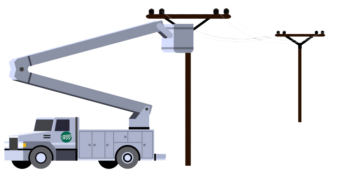$374723
2021 Return
$358394
2022 Return
$20000000
Total Return to Members Since 1959
What are Capital Credits?
- As a member consumer of an electric cooperative, you and your fellow member consumers own the electric company that serves you. One benefit of ownership is capital credits.
- Since the Cooperative operates on a not-for-profit basis, all of the margins are returned to our member-consumers in the form of capital credits, an investment in each owner’s name.
- These capital credits form the bulk of the cooperative’s equity and is a measure of its financial strength.
- The funds are used as working capital to build the facilities needed to serve you and future member- consumers.
The Cooperative Difference
- Unlike investor-owned utilities who provide electric service for a profit, Community Electric Cooperative is a member-owned organization that returns profits, called “margins” in the cooperative business, back to its members.

- When you sign up to receive electric service from CEC, you become a member of our electric utility, a part-owner who invests equitably in the co-op.
- CEC is a not-for-profit organization, so at the end of each year when our financial books are closed, any margins are allocated to be returned to you, the members.
- The amount allocated to each member is based on how much electricity they used in that year, and is paid back to the member later in the form of a capital credit retirement.
How It Works
- Capital credits are not refunded, or “retired,” immediately. Because the electric utility business requires large amounts of capital to operate, electric cooperatives reinvest capital credits into their business operations.

- We reinvest these capital credits toward improving and expanding our electric system and meeting our other capital needs.
- Capital credits also reduce our need to borrow money, which keeps monthly rates for members down and helps us provide you, the member, with more reliable electric service.
- During this time, CEC carefully keeps track of the amount owed to each individual member to ensure all members can receive the correct amount in their capital credit refund when the time comes to retire them.
Financial Evaluation

- Each year, the board of directors evaluates the financial condition of the cooperative to determine when it is financially feasible and prudent to officially retire capital credits for a given calendar year.
- We may not retire capital credits every year. When the board decides to retire capital credits, we calculate the exact amount we need to pay each member. At this time, you will receive a check for your portion of the year’s capital credit refund.
Other Important Information
- If you ever move out of our service territory, it is very important that you provide CEC with a forwarding or current address to ensure you receive your capital credit money.

- Former members may be eligible to receive capital credit refunds for years after moving out of CEC’s service territory depending on the number of years spent as a member and the percentage of electricity used for those years.
- To avoid missing out on this free refund, it is critical to keep Community Electric aware of any change of address.
Frequently Asked Questions
A cooperative does not earn profits in the sense that other businesses do. Instead, any margins, or revenues remaining after all expenses have been paid, are returned to the members in proportion to their usage of the co-op’s services through capital credits allocations and retirements. Capital credits represent each member’s share of the cooperative’s margins and ownership of the co-op.
A cooperative does not earn profits in the sense that other businesses do. Instead, any margins, or revenues remaining after all expenses have been paid, are returned to the members in proportion to their usage of the co-op’s services through capital credits allocations and retirements. Capital credits represent each member’s share of the cooperative’s margins and ownership of the co-op.
Every business needs to maintain a suitable balance between debt and equity to ensure its financial health and stability. Capital credits are the most significant source of equity for most electric cooperatives. Equity is used to help meet the expenses of the co-op, such as paying for new equipment to serve members and repaying debt. Capital credits help keep rates at a competitive level by reducing the amount of funds that must be borrowed.
Capital credits are allocated to each member of the cooperative every year based on participation in the cooperative. The board of directors determines the basis for the allocation. Frequently, the allocations are based on such measures as the total dollar amount of services purchased or kilowatt-hours (kwh) of electricity consumed.
Most cooperatives notify members of annual capital credits allocations through a letter, a message on each member’s bill, the co-op’s website or other methods.
Each year the board of directors determines whether the co-op’s financial position permits the return, or retirement, of capital credits and, if so, what amount of capital credits will be retired.
The board also decides the method for determining which capital credits are returned. For example, many cooperatives retire capital credits using the First-in, First-out, or FIFO, method. That means that the capital credits that have been invested in the cooperative for the longest period of time are returned to members first. A cooperative using the FIFO method might return capital credits allocated in 1984 to members in 2004.
Other co-ops retire capital credits using the percentage method. That means that a portion of the total amount of capital credits allocated to a member over time are returned each year.
Another way to retire capital credits is to use a combination of methods, such as the FIFO/Percentage hybrid, which makes part of the capital credits retirement on the FIFO basis and part using the percentage method. The Last-in, First-out, or LIFO, method, which repays capital credits that have been invested in the cooperative for the shortest period of time first, is rarely used alone, but the FIFO/LIFO hybrid is a popular approach.
The approach that works best for an individual system depends on a number of factors, including the age and tenure of its membership.
Some cooperatives are prohibited from paying interest on capital credits by their articles of incorporation or other legal documents. Whether that is the case, co-ops do not pay interest on capital credits, because the money to pay that interest would have to be collected from members through higher rates.
A member who terminates service no longer receives additional capital credits allocations. The balance in the member’s capital credits account is maintained until it is retired in full.
It usually is the member’s responsibility to notify the co-op of any changes in address so that the member can be located when it is time for the co-op to retire capital credits allocated to the member’s account.
Capital credits in the member’s account belong to the member’s estate. In order to assist the member’s heirs in closing the estate, some co-ops offer a special capital credits retirement of the outstanding balance of the deceased member’s capital credits account, often at a discount.
In the interest of fairness to all members, some co-ops discount capital credits retirements, such as special retirements to estates, to reflect the net present value of making a capital credits retirement now that would otherwise be made at a later date. The smaller amount received today, if invested until the normal retirement date, would be equal to the normal retirement amount.
The board of directors has a fiscal responsibility to maintain the financial integrity of the cooperative in a way that provides competitive rates and allows the return of capital credits to members. Having a sound equity management plan and a commitment to serving the members are key to achieving this.
Capital credits are a return of money paid for electricity in a previous year and are generally not taxable income for residential consumers. Commercial and industrial consumers should discuss any capital credits retirements with their tax advisers.
Unclaimed Capital Credits
All members have until the last business day in September to claim their Capital Credit. Once past that date, all remaining credits will be considered abandoned.
New wpDataTable
| wdt_ID | Adkins, Marion T |
|---|---|
| 1 | Alberg, Kenneth |
| 2 | Alexander, Alton K |
| 3 | Alexander, David L |
| 4 | Allen Grove Baptist Church |
| 5 | Allen Metal Works |
| 6 | Allen, Aaron M |
| 7 | Allen, George P |
| 8 | Allison III, Walter H |
| 9 | Alphin, Betty J |
| 10 | Ambrose, Joseph F |
| Adkins, Marion T |
